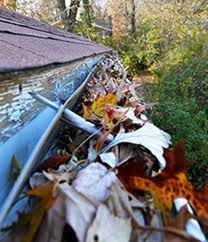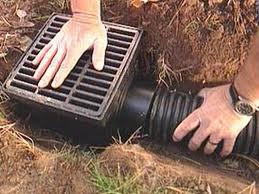Good gutter and great soil drainage tips.
 Good gutters.
Good gutters.
Roof drainage is, by far, the number one cause of basement leakage. Since roof surfaces are as large as the house, they collect lots of water in heavy rainstorms. What happens to that collected water can mean the difference between a wet and a dry basement.
Properly designed gutters should have at least one downspout for every 600 to 800 square feet of roof surface. Gutters must be clean, because dirty gutters fill up and the water overflows directly to where you don't want it: near the foundation.
It is also important to make sure the ends of the downspouts are extended to discharge at least four to six feet from the foundation. Spouts which discharge too close to the foundation are like big fire hoses blasting water into the basement.
If your yard and local building laws permit, one of the best ways to control roof drainage is to discharge downspouts into solid PVC plumbing pipes that run underground and release water to the street or to another low-lying area. When making this improvement, be sure to pitch the pipe slightly toward the discharge point to avoid backups.
Do not attempt this with the soft, flexible black pipe that landscapers like to use around flower beds, because it's easily crushed and cannot be snaked clean like PVC plumbing pipe can.
 Sloping soils.
Sloping soils.
Next to gutter problems, the angle of the soil around the foundation perimeter can also cause wet basement woes. The soil should slope away from the house to keep rainfall from collecting against foundation walls.
The angle and type of soil are also important. The soil should slope downward six inches over the first four feet from the foundation wall.
From here it can be graded more gradually but should never allow water to run back toward the house.
If grading needs improvement, use clean fill dirt (not topsoil) to build up the soil around your house. Tamp the soil down to the correct slope and finish with a layer of topsoil and grass seed to prevent erosion. Or, just use stone or mulch. Whatever the top layer is, be certain the slope is established with the fill dirt, or else the water will just run through the more porous material and into the basement.
Do not use straight topsoil for the grading improvement. This kind of soil is too organic and will hold water against the foundation, which is the opposite of what needs to be done.
It is also important to avoid landscape treatments that hold soil close to the house. A brick, stone or timber landscape edging around flower beds adjacent to foundation walls may look attractive, but these edges can prevent water from draining away from the foundation and increase your risk of basement flooding.
Following these simple guidelines will solve 99 percent of wet basement blues. These waterproofing improvements are inexpensive and can usually be done yourself or with a little help from your friends.
Click this button or ring 0800 CAN FIX any time of the day or night to make an appointment or request a free quote - we are happy to help!













